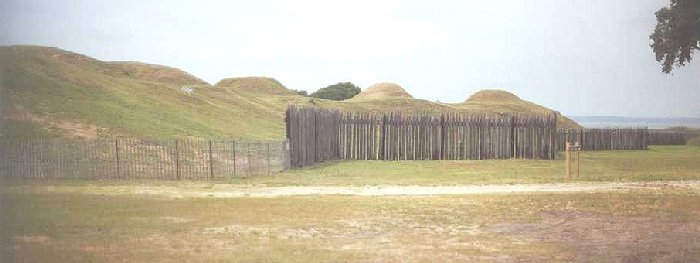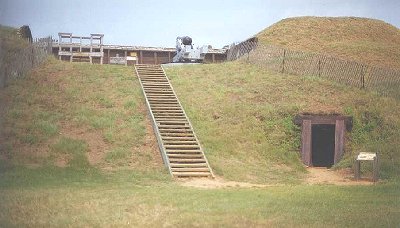
Fort Fisher
January 15, 1865
Although the Union blockade was originally quite weak, the Union navy grew much larger and posed a grave threat to the Confederate war effort. A certain number of blockade runners always got through so the Union army was required to completely shut off Confederate trade by capturing the ports. By late 1864, only Wilmington, NC remained to supply Lee's army.
In December 1864, a joint army/navy force of 6,500 men under Benjamin Butler and David Porter was sent to take Fort Fisher, the earthen fort manned by 800 Confederates guarding the entrance up the Cape Fear River to Wilmington. An old ship was packed with 200 tons of gunpowder was sailed near the fort and exploded. The fort was undamaged so troops were landed on the peninsula. After a failed naval bombardment in which defective Union guns killed more sailors than Confederates, the expedition was called off. Butler, a political appointee, was sacked as he was no longer useful to Lincoln after his successful re-election.
Grant decided to make another attempt, but by now the garrison had been increased to 1,500 men and Hoke's division had arrived in the area for support. The new Union attempt would be made by Porter and 8,000 men under Gen. Alfred Terry. The men landed on the peninsula on January 12th, digging in and cutting the fort off from Hoke's supporting division. Two days later, Porter again bombarded the fort, this time successfully, knocking out most of the 20 land faced Confederate guns. The next day, January 15th, the Union force would storm the fort.

The Land Facing Wall
The garrison commander, Col. William Lamb, had had two years to construct his defenses. The land faced earthen wall, nearly half a mile long at the time, was 30 feet high and 25 feet thick. Atop the parapet were 15 traverses which protected the guns from flanking fire. A wooden palisade impeded the Union infantry. The land in front of the walls had been rigged with electrically triggered land mines. In all, the defenses were formidable.
Terry's men set up sharpshooters and prepared to assault the fort's left flank, on the river side of its defenses while a force of sailors attacked the Northeast Bastion along the beach, where the land and sea faces met. The sailors became restless and attacked before the army. The men where badly cut up and repulsed, but they had distracted Confederate attention to the beach at just the right time.

Shepherd's Battery Looking Toward the River
This is the left flank of the line which angled outward to enfilade attackers. This portion of the line was occupied by Shepherd's battery, whose guns had been knocked out of action by the bombardment. The Wilmington Road crossed a wooden bridge and entered the fort between the earthworks and the river visible in the background. This area was marshy and protected by two pices of field artillery, sandbags, and the palisade, but it was the weak spot of the line and the Yankees concetrated against it.
At about 3:30 PM, the assault commenced, led by Curtis's brigade. The land mines did not work since the bombardment had cut the lines. Union troops breached the palisade fronting Shepherd's battery and scaled the wall. Meanwhile, the Yankees had bogged down in the marsh at the river gate exposed to rifle fire and canister shot. The fighting raged for about 20 minutes until the Yankees took the parapet of Shepherd's battery and poured fire down on the Confederates defending the gate, but the defenders still held.
Terry sent in Pennypacker's brigade, and these men combined with Curtis's forced their way through the gate and along the earthworks. Confederate Gen. Chase Whiting led 500 men in a counterattack and was severly wounded, but the Yankees stalled at the third traverse and in the low ground behind Shepherd's battery, despite now being reinforced by Bell's brigade.

Rear View of a Shepherd's Battery Gun Position
Typically guns were paired together and protected by traverses on each side to protect against flanking fire. Ammunition was stored in dugouts like the one seen on the right. As the battle raged, some Confederates remained in the dugouts and refused to leave. Fighting was especially sever as Union and Confederate troops opposed each other from different side of the traverses, holding up their rifles and firing down on their enemies or rushing them and fighting hand to hand. At times the dead and wounded made it difficult to continue the attack.